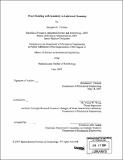Wear modeling with sensitivity to lubricant chemistry
Author(s)
Thomas, Benjamin C. (Benjamin Carl)
DownloadFull printable version (4.345Mb)
Other Contributors
Massachusetts Institute of Technology. Dept. of Mechanical Engineering.
Advisor
Victor W. Wang.
Terms of use
Metadata
Show full item recordAbstract
The life of an automotive engine is often limited by the ability of its components to resist wear. Zinc dialkyl-dithiophosphate (ZDDP) is an engine oil additive that reduces wear in an engine by forming solid antiwear films at points of moving contact. The effects of this additive are fairly well understood, but there is little theory behind the kinetics of antiwear film formation and removal. This lack of dynamic modeling makes it difficult to predict the effects of wear at the design stage for an engine component or a lubricant formulation. The purpose of this research is to develop a theoretical and numerical framework for modeling the formation and evolution of ZDDP antiwear films based on the relevant chemical pathways and physical mechanisms at work. The ability to predict the development and function of thin solid films on rough surfaces and their effect on surface wear would be a useful tool in many tribological applications, both automotive and otherwise. Completely deterministic modeling of such films may not be possible due to the complex interactions between the numerous mechanical, thermal, and chemical variables over disparate magnitudes of time and length scales. However, it is believed that useful predictions can be made by constructing a mechanistic model in which all of the most important effects are included, even if only at an approximate level. Both the theoretical model and the numerical implementation of the concepts therein will be discussed in this work. Preliminary results from this effort are presented to illustrate feasibility and functionality on a qualitative level.
Description
Thesis (S.M.)--Massachusetts Institute of Technology, Dept. of Mechanical Engineering, 2007. Page 91 blank. Includes bibliographical references (p. 85-87).
Date issued
2007Department
Massachusetts Institute of Technology. Department of Mechanical EngineeringPublisher
Massachusetts Institute of Technology
Keywords
Mechanical Engineering.